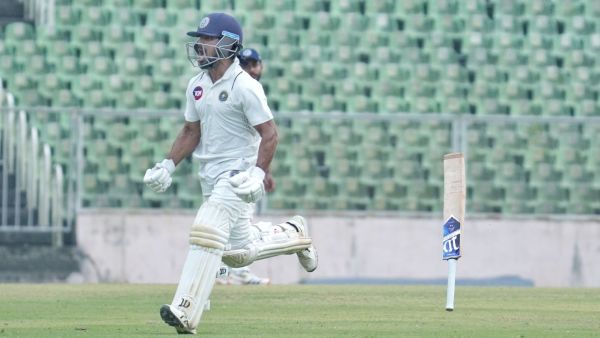Meet Kerala’s cricket stars, Azharuddeen from Thalangara, Kunnummal from Koyilandy, Baby from Adimali
From distant Kasaragod to capital Thiruvananthapuram – a timeless line the loudspeakers blare during poll campaigns in Kerala, implying the reach of a party or a candidate from the northern tail to the southern tip of the State. From this Monday, fans, friends, and families of cricketers, along the 577-kilometre-long stretch that curves like a fish, would flock around television sets or hunch over smartphone screens to watch Kerala tussle Gujarat in Ahmedabad for a historic appearance in a Ranji Trophy final.
Last week, a quiet town in southern Kasaragod, once famous for hand-woven prayer caps, was abuzz with festivities when local boy Mohammed Azharuddeen helped Kerala grind out a draw against Jammu and Kashmir in Pune. Some 380 kilometres away, on the banks of Thodupuzha river in Kanjiramattom in Ernakulam district, neighbours thronged medium pacer MD Nidheesh’s house.
 Kerala player Salman Nazir. (KCA)
Kerala player Salman Nazir. (KCA)
The most famous draw in Kerala’s cricket landscape connected hitherto incongruous towns and villages. Man of the match and batting talisman Salman Nizar is from Thalassery, the birthplace of cricket in the state. Akshay Chandran, whose resistance was equally valuable, was born in Kochi, before moving to Kannur and then polishing the game in Thalassery. The captain Sachin Baby is from Adimali in Idukki; Basil Thampi and N Basil are from Perumbavoor, dotted with plywood factories, in Ernakulam district; KM Asif is from Kottayam, Rohan Kunnummal hails from Palakkad, although raised in Kozhikode’s Koyilandy, and Shoun Roger is from Vettukad, in the north-west coast of Thiruvananthapuram.
Club culture
Except Thiruvananthapuram and Thalassery, none are traditional cricketing nurseries, even though they are all cricket mad and possess facilities of varying ranges. Thalangara, says Azhar’s brother Unais, has about 20-25 clubs that regularly encounter in tournaments. “Thalangara has a good ecosystem for budding cricketers. It’s a small town, but we have around 20 cricket clubs. We are mad about football, but madder about cricket,” he says.
As is Perumbavoor, where Basil Thampi nurtured his cricketing dreams. Says his friend, Jithin George, of the Perumbavoor Cricket Club: “Every weekend, you could watch dozens of leather-ball games. Tennis ball tournaments could be more popular, but there are devoted clubs for leather balls too, playing for the kick of it as well as the hope of turning up for the State or the country.”
The pathway to the state-side starts at the summer coaching camp organised in the vacation months in each of the 14 districts. “Hundreds turn up. We watch each one of them in search of a bright spark. It’s the reason we have players from most parts of Kerala, unlike in the past where most came from Kochi, Thiruvananthapuram or Thalassery,” says OV Mazhar Moidu, former assistant coach of Kerala as well as the fielding coach of the India A team that toured Australia last year.
To one of the camps, he dragged along an energetic 10-year-old, batting-mad neighbour. He was Salman. “He used to play with his brothers and cousins in his ancestral house, which was close to my house. I took him along and instantly saw the spark. And he backed his gifts with hard work.”
Story continues below this ad
To meet the bus fare to attend the camp in Kochi, the nearest town from his village, Nidheesh accompanied his friends to paint houses in the neighbourhood.
When Sachin started his career — he was named thus by his father the day after his famous namesake Sachin Tendulkar made his Test debut in Gujranwala in 1989 — summer camp happened only in the cities. So he was largely self-coached. “Just by observing how they batted in live games or in the highlights, picking a lot of points from commentators too,” he had once told this newspaper.
Even for selection trials, he had to travel 60km to Kochi. The left-handed batsman was picked in the U-13 district squad, but played barely a couple of matches. The scene has changed drastically.
“The best of talents we pick are sent to the elite centres, where they are constantly mentored and monitored. They constantly play tournaments, like the inter-district and zonal ones. Among them, the best ones make the list of probables in the particular age-group, before the same process follows in the next age-group. The filtering system is robust,” says Mazhar.
Story continues below this ad
KCA tournaments
Even if someone misses out, there are KCA tournaments that give them second chances. “Several players have benefitted from it, like white-ball all-rounder NM Sharafuddeen. The aim is to ensure that no talent goes unnoticed or without the opportunities to show his talents,” he says.
 (From left): Md Azharuddeen and the Kerala Ranji team celebrating their victory over Jammu and Kashmir. (news Photo)
(From left): Md Azharuddeen and the Kerala Ranji team celebrating their victory over Jammu and Kashmir. (news Photo)
But the selection for Ranji Trophy is more regimented. Explains former cricketer and coach P Balachandran: “We have a core group of 20-30 players. We don’t shuffle the pack, and are reaping the rewards. You can see their bond, they have played a lot of cricket together, and know each other well. One sticks his leg for the other, as you would have noticed during the partnerships. Most of them are in a similar age-group to (late 20s to early 30s)”. For instance, Salman and Azhar, the Pune heroes, had been friends since 2010, when they met at the Elite Academy in Kochi.
Step into the dressing room, the ears would burst with a variety of slangs. Azhar’s Kasargod twang, with its nasal lilts and Tulu-Kannada inflections, could be more Latin for Sachin from the Idukki, where they speak Malayalam with a central Kerala uptalk. It blends different backgrounds too. Azhar’s father was in the Middle East. Salman’s father had worked in the Gulf too; Rogers lived in Sharjah till he was 13, Nidheesh’s father was a clam shell harvester. Sachin’s father was an LIC agent, Akshay Chandran’s an officer in the Navy. Thampi’s family survived on his father’s small chips business, and Rohan’s father is an entrepreneur and mother a bank manager. But everything blurs in their quest for collective glory, which has rippled feverish excitement from Kasaragod to Thiruvananthapuram.
